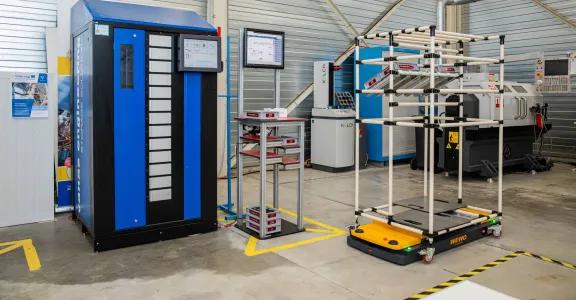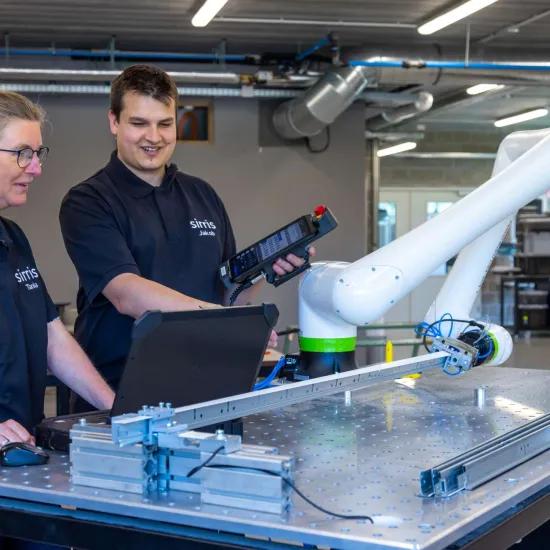While AGVs and AMRs can bring significant benefits in terms of efficiency and productivity, they also introduce new safety risks that must be addressed. In a series of blogs, we will explore AGV safety from multiple angles. In this third and final blog post, we will examine the responsibilities of each stakeholder and their role in mitigating risks and ensuring safety.
Automated guided vehicles (AGVs) and autonomous mobile robots (AMRs) are becoming increasingly common in manufacturing, warehousing, and logistics operations. While these vehicles can bring significant benefits in terms of efficiency and productivity, they also introduce new safety risks that must be addressed. In a series of blogs, we have been exploring AGV safety from multiple angles, including the legislative framework that governs it, the road toward safety in terms of best practices, and the stakeholders involved and their respective responsibilities. Our comprehensive exploration of AGV safety will provide valuable insights into the challenges and opportunities associated with this rapidly developing field.
AGV/AMR system safety responsibilities
In our previous blog posts, we have explored the legislative framework that governs AGV safety and the safety assessment process for AGV systems. While regulatory compliance and safety assessments are crucial for ensuring AGV safety, the responsibilities of stakeholders cannot be overlooked. The manufacturer, integrator, and end-user all play critical roles in ensuring the safety of AGV systems. In this third blog post of our series, we will examine the responsibilities of each stakeholder and their role in mitigating risks and ensuring safety. By understanding the responsibilities of each stakeholder, organizations can ensure that all parties involved work together to create a safe and efficient AGV system.
Stakeholders for AGV system safety are the manufacturer, the integrator and the user.
Manufacturer responsibilities
Over and above the design and manufacturing of a safe AGV/AMR as per the Machinery Directive (MD)., the manufacturer must also supply adequate documentation, in particular instructions for bringing the AGV/AMR into service within a AGV/AMR system, instructions for use and operation and maintenance of the AGV/AMR, and a list of identified residual risks for the AGV.
Integrator responsibilities
It should be noted that CE marking only covers the AGV/AMR itself, and not the AGV system as a whole. The person integrating the AGV/AMR must ensure complete installation and that all risks are dealt with or identified. This includes:
Should the AGV/AMR be brought into service outside the scope of manufacturer’s limits, the integrator (or final user) must integrate further protection to guarantee that safety standards are abided by for the application as a whole. The integrator must therefore specify the intended use and limits of the AGV system, and conduct risk assessment for the AGV system, taking into account the specifications, intended use and limits of the employed AGV.
User responsibilities
The safety of industrial robot installations ultimately rests with the user. As a stakeholder, the user has specific responsibilities, including verifying and ensuring that a thorough risk assessment is conducted and documented for the system and its environment. Additionally, the user must ensure that the AGV system is inspected both after assembly and before its first use, as well as at regular intervals while in operation. The AGV system should only be used in accordance with its intended use. The user must also ensure that all necessary administrative measures are in place, such as providing adequate training, implementing zone access control, and providing employees with the required Personal Protective Equipment (PPE).
The lifecycle of a mobile robot ends with decommissioning, which involves specific risks, particularly related to battery disposal and machine removal. In this phase, the end-user is responsible for ensuring these processes comply with safety and environmental regulations, unless these responsibilities are delegated to a third party through a detailed contract.
Safety, an ongoing process
To conclude this blog series, we have explored multiple angles of AGV and AMR safety, including the legislative framework that governs it, the safety assessment process for AGV and AMR systems, and the responsibilities of stakeholders involved. AGVs and AMRs have become increasingly common in manufacturing, warehousing, and logistics operations, and while they bring significant benefits in terms of efficiency and productivity, they also introduce new safety risks that must be addressed.
We hope that this blog series has provided readers with a comprehensive understanding of AGV safety and the importance of taking a proactive approach to mitigate risks and ensure regulatory compliance. However, AGV safety is an ongoing process that requires continuous improvement and monitoring. We encourage readers to take action and assess their own AGV systems to ensure they are compliant with regulatory requirements and incorporate best practices to minimize potential risks.
As a company, how can you assess how to sensibly deploy AGVs or AMRs, and what are the steps involved in such a process? Contact us!
This blog post has been published in the context of the Standards Cell Industry 4.0 and the FlexIn²Log project, which aims to support manufacturing companies and their logistics and ICT partners to use digital technologies and platforms, and digitally driven AMRs, to increase the flexibility and efficiency of inbound and internal logistics.






